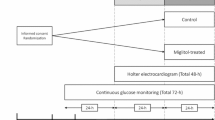Abstract
Patients with type 2 diabetes are at increased susceptibility to a prolonged QT interval. Furthermore, insulin secretagogues, drugs used to treat diabetes, may prolong QT interval and provoke arrhythmias. We evaluated whether secretagogues can affect QTc interval during cardiac stress test in 20 patients with type 2 diabetes treated with secretagogues. ECG stress test was performed in all patients. QTc interval was calculated both before cardiac stress test (BCST) and at acme of cardiac stress test (ACST). Diabetic patients treated with secretagogues showed longer QTc-ACST values than those treated with metformin only. QTc-ACST values resulted shorter than QTc-BCST values in control group. Diabetic patients treated with secretagogues showed QTc-ACST values significantly longer than QTc-BCST values. In our study, diabetic patients treated with secretagogues did not show the QTc physiologic decrease that is a protective against arrhythmias. These results suggest to evaluate, in these patients, QT length, even during routine cardiac stress test.

Similar content being viewed by others
References
Veglio M, Bruno G, Borra M (2002) Prevalence of increate QT interval duration and dispersion in type 2 diabetic patients and its relationship with coronary heart disease: a population-based cohort. J Internal Med 251:317–324
Cardoso CR, Salles GF, Deccache WJ (2003) Prognostic value of QT interval parameters in type 2 diabetes mellitus: results of a long-term follow-up prospective study. Diabetes Complications 17(4):169–178
Whitsel EA, Boyko EJ, Rautaharju PM et al (2005) Electrocardiographic QT interval prolongation and risk of primary cardiac arrest in diabetic patients. Diabetes Care 28(8):2045–2047
Stettler C, Bearth A, Allemann S et al (2007) QTc interval and resting heart rate as long-term predictors of mortality in type 1 and type 2 diabetes mellitus: a 23-year follow-up. Diabetologia 50(1):186–194
Christensen PK, Gall MA, Major-Pedersen A et al (2000) QTc interval length and QT dispersion as predictors of mortality in patients with non-insulin-dependent diabetes. Scand J Clin Lab Invest 60(4):323–332
Okin PM, Devereux RB, Lee ET, Galloway JM (2004) Strong heart study. Electrocardiographic repolarization complexity and abnormality predict all-cause and cardiovascular mortality in diabetes: the strong heart study. Diabetes 53(2):434–440
Marfella R, Nappo F, De Angelis L, Siniscalchi M, Rossi F, Giugliano D (2000) The effect of acute hyperglycaemia on QTc duration in healthy man. Diabetologia 43(5):571–575
Haverkamp W, Breithardt G, Camm AJ et al (2000) The potential for QT prolongation and proarrhythmia by non-antiarrhythmic drugs: clinical and regulatory implications. Report on a policy conference of the European Society of Cardiology. Eur Heart J 21(15):1216–1231
Quast U, Stephan D, Bieger S, Russ U (2004) The impact of ATP-sensitive K + channel subtype selectivity of insulin secretagogues for the coronary vasculature and the myocardium. Diabetes 53(Suppl 3):S156–S164
Stephan D, Winkler M, Kühner P, Russ U, Quast U (2006) Selectivity of repaglinide and glibenclamide for the pancreatic over the cardiovascular K(ATP) channels. Diabetologia 49(9):2039–2048 Epub 2006 Jul 25
Terzic A, Jahangir A, Kurachi Y (1995) Cardiac ATP-sensitive K + channels: regulation by intracellular nucleotides and K + channel-opening drugs. Am J Physiol 269(3 Pt 1):C525–C545
Najeed SA, Khan IA, Molnar J, Somberg JC (2002) Differential effect of glyburide (glibenclamide) and metformin on QT dispersion: a potential adenosine triphosphate sensitive K + channel effect. Am J Cardiol 90(10):1103–1106
Ikeda T (1994) QT prolongation in type 2 diabetes mellitus treated with glibenclamide. Diabete Metab 20(6):565–567
ACC/AHA (2002) guideline update for exercise testing: summary article. A report of the American College of Cardiology/American Heart Association Task Force on Practice Guidelines (Committee to Update the 1997 Exercise Testing Guidelines).Gibbons RJ, Balady GJ, Bricker JT et al. American College of Cardiology/American Heart Association Task Force on Practice Guidelines. Committee to Update the 1997 Exercise Testing Guidelines J Am Coll Cardiol 40(8):1531–1540
Bazett HC (1920) An analysis of the time relations of electrocardiograms. Heart 7:353–370
Siscovick DS (2010) Type 2 diabetes mellitus and the risk of sudden cardiac arrest in the community. Rev Endocr Metab Disord 11(1):53–59
Author information
Authors and Affiliations
Corresponding author
Additional information
Communicated by Guido Pozza.
Rights and permissions
About this article
Cite this article
Curione, M., Di Bona, S., Amato, S. et al. Lack of the QTc physiologic decrease during cardiac stress test in patients with type 2 diabetes treated with secretagogues. Acta Diabetol 51, 31–33 (2014). https://doi.org/10.1007/s00592-012-0438-6
Received:
Accepted:
Published:
Issue Date:
DOI: https://doi.org/10.1007/s00592-012-0438-6




